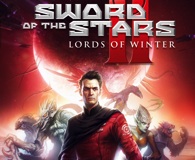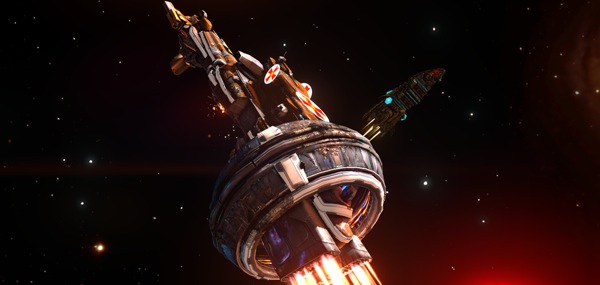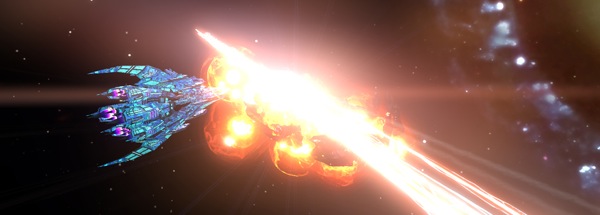Sword of the Stars II – PC Game Review
 Sword of the Stars II: Lords of Winter. PC Game. Publisher: Paradox Interactive. Developer: Kerberos Productions. $29.99 download.
Sword of the Stars II: Lords of Winter. PC Game. Publisher: Paradox Interactive. Developer: Kerberos Productions. $29.99 download.
Passed Inspection: Good interface. Solid core mechanics. Improved graphics. Fun tactical battles.
Failed Basic: Strategy map graphics are too busy at times. Game released prematurely and undergoing continuous patching. No campaign or scenarios, just skirmish maps. Needs more personality integrated into the gameplay.
Strategy game fans, especially those of neglected genres like 4X space strategy, are used to having games stew in the pot a little after released. That is, being tweaked by patches to improve the game. It’s expected when everything from the interface to the balancing of units has more complexity than the average shooter or even role-playing game. But there is a point, if I may continue with my catchy food metaphors, that although the meal may not be done, it is fit to serve. Sword of the Stars II was served up raw.
{default}From day one of release there were numerous patches that didn’t seek to improve the game, but merely make it playable. Each patch’s release notes read more like what a beta tester should catch, fixing everything from crashes to missing graphics and non-working features. Every day it seemed there was a new update on Steam, and they still continue. The fact that these were released in such succession suggests that many of the issues were known before the game shipped. So we are left with the question of overzealous publisher deadline or overzealous developers?
But the point of this review is not to wax on about release dates and the patching process, but to inform you, as an Armchair General that likes to take your command skills above the stratosphere at times, if this is a game that is worth your investment in time and money. The answer right now is no. It’s a shame, too, because the original Sword of the Stars (complete with its three expansion packs) is a little gem of a game that got better with time and is a feature-rich addition to the genre. So what went wrong? I’m not sure, considering the sequel looks and feels so similar to the original.

A cruiser finds trouble—but isn’t that what cruisers are for?
The Sword of the Stars series has all the staples of the genre—research, combat, exploration and diplomacy—but features a few interesting differences that set it apart. Upon setting off from your home system to explore the galaxy and colonize new planets, exploration is dictated by how your particular race—of which there are six—travels the stars. For instance, the humans are able to travel on set "node" paths between systems, while the insect-like Hivers must construct jump gates, while another is able to teleport to any system.
Systems are laid out not on a 2D plane, such as in Master of Orion 2 or Galactic Civilizations, but in a 3D, rotatable field. This makes for a more complex game, especially on the largest maps, as you must keep an overall picture of just where your colonies lie in relation to the enemy and how said enemy can and cannot get to you—and vice versa.
The next difference is the way research operates. Within the 14 different areas of research, some techs may require a "feasibility study" before you can research it. You may then be notified that your scientists find it unfeasible to research a particular tech. Also, available techs are randomized. This adds a neat little twist in that you can’t develop a single research path to rely on every time but have to adapt to what you are given. Regardless, there are always a multitude of interesting techs to research, and this is one area in which the game excels.
While Sword of the Stars II builds on the lore established in the first game and its three expansions, the lack of any campaign, or even single scenarios, really makes this pointless, as the only way for players, especially those new to the series, to put any of this into context is through perusing the in-game encyclopedia. Those willing to delve into it will find a wealth of information on the history of the Sword of the Stars universe and its six races. It would have been nice for this to be ancillary, however, to a campaign that introduced these races and their backstories, especially since the reason for the sequel is the titular Lords of Winter and the new threat they bring to a galaxy at war. While loading up a game, you are treated to some great artwork and lore; it is just a shame this could not translate as effectively into the game itself. As it is, there is not even an in-game tutorial. Players have the option to download a manual or watch a video tutorial of the gameplay. Again, just a sign that this game was not given the time it needed to mature into a full-featured product.
When you are ready to get a game started (multiplayer lobbies are generally home to only a few people at a time), you can choose from 25 maps of varying sizes, each presenting a different challenge, be it a race for the systems in the center of a map or close starting positions that force players to branch outward to achieve victory—all pretty standard stuff.
Alas, there is no option to randomly generate a map or create one of your own, so until the developers add more, or an expansion is released, that is it. The available maps do allow for a good deal of customization, however, such as starting systems, initial technology level, time limit for battles, and victory conditions.

A starship meets its spectacular end. Graphics in Sword of the Stars II are an improvement over those of the original game, but unfortunately not much else is.
Gameplay consists of using your scout ships to explore, colonizing new planets, and continuing to increase your financial and military power through research. You can fully customize ships by choosing which weapons and modules to attach to certain hard-points. While this is nowhere near the complexity of the ship designer in Galactic Civilizations 2 (or even Master of Orion 2) it is still fun fiddling with different load-outs. A neat feature is being able to jump into the battle mode to test your design on static targets (literally giant bull’s-eyes) positioned on all sides of your war vessel. This is important, since the real-time battles take place in four dimensions and you must maneuver your ships to get an advantageous position based on your weapon load-out. It would have been nice to be able to simulate a battle on the fly to test out their mettle as well.
The game’s focus is clearly on building, maneuvering, customizing, and battling your ships, as systems are treated in very broad terms. You can set your finances to emphasize research or infrastructure, but there is not a long list of interesting buildings to construct on your planets. There are no pleasure domes to appease your populace or intergalactic banks to increase your financial output. You simply build stations that are dedicated to a handful of different objectives, such as repair, research, or commerce. This will appeal to those that want to concentrate on playing fleet commander, but players that like a little more personality in their strategy game will not find it here.
Music is almost non-existent, other than at the main menu and during battles. The rest of the time you will be treated to a sort of background hum that is supposed to evoke the depth and void of space. There are serviceable voiceovers when ordering fleets about or when starting build orders and various other tasks, but nothing particularly interesting. The sounds during battle, however, are the best of the bunch and pack a satisfying punch.
The graphics go for a bright, almost neon-like look, which can be cool to observe, but can also get in the way of clearly seeing the space map, as it starts to look a bit busy. Clicking on a planet and having bright red and blue rings around it can be a bit jarring. I took a look at the first Sword of the Stars game to see the difference, and it seemed to be handled a little better in the first game, with the space map a little less crowded. This graphic style translates better in battles, which tend to be impressive-looking light shows as UV beams and lasers broadside enemy ships.
Another aspect I was pleased with was the interface, which presents everything clearly. It took me only one game to figure out how to run things, without having to consult the manual.
I think you get the idea that this game is a work in progress. Why would a gamer wish to spend valuable time playing a game that is not even as complete as its predecessor? The overall feel is similar to the original, and the graphics are indeed a step up, but it’s hard to recommend when there could still be features missing, AI weaknesses, and bugs that can affect your game. If you have an itch to play a space strategy game, there are a few great choices that will entertain for hours. This sequel is an unfinished game that will no doubt improve with time if the developers continue to be dedicated to fixing it. Theoretically there is nothing wrong with the game’s focus and direction. Leave this one in the dry-dock for now, but dedicated space generals itching for a new game to play may want to keep an eye on the game’s forums or patch notes. Me, I’m off to play the original.
Armchair General Rating: 60%
About the Author
Anthony Micari graduated from New York University with a degree in History. He runs a business, is an avid reader, and plays of all manner of games even since getting his start on a Commodore 128. He has also published in Wargamer.


Will you review the game after the “all clear” flag goes up? It is due to be fully “done” by the end of the month. I promise that your experience will be much different then. I see that you wrote your review on may 1. On may 3 a patch came out that greatly increased performance and added all but a few of the missing features. On may 10 there will be another update with an emphasis on bugfixes, then a couple more after that. The developers stated that the game will be done within the month.
Check the developer forum for updates at http://kerberos-productions.com/forum
The review was, in my opinion, very superficial. I could tell that the graphics were nicer from sceenshots, and the bugs issue is readily available. Insight into new features, how well they’re implemented and what’s better or worse, for instance, would be nice. This review is extremely basic and doesn’t really delve beyond what a player would find in 40 minutes of game play.
will there be a second review now that the all clear has been given
http://www.kerberos-productions.com/forums/viewtopic.php?f=37&t=35604
I just spent several hours playing this game with no problems. I know it was really screwed up at initial release, but believe a second review it probably warranted. It is a good game now, IMO.